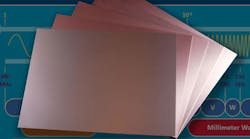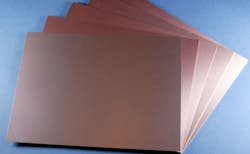As wireless applications continue to expand, uncluttered RF and microwave frequencies are quickly vanishing, inviting circuit designers to look higher. Millimeter-wave (mmWave) frequencies (30 to 300 GHz) offer plenty of available bandwidth if practical components, starting with printed-circuit-board (PCB) materials, can be found to process such high-frequency signals. Fortunately, several materials from Rogers Corp. fit the mold for low-loss circuit projects through 77 GHz and higher, including RO3003 and RO4350B circuit materials.
For mmWave circuits, those higher frequencies mean much smaller signal wavelengths than at lower frequencies, requiring PCB materials that can deliver performance goals beyond the levels required at lower frequencies. Insertion loss is one of the key performance parameters at mmWave frequencies, where signal power tends to be much more difficult to generate and maintain than at lower frequencies.
In terms of PCB materials, insertion loss comprises four loss components: conductor loss, dielectric loss, radiation loss, and leakage loss. Conductor and dielectric losses are usually the loss components of main interest when specifying mmWave PCB materials, with the goal of minimizing transmission-line losses though the PCB.
Conductor losses are a function of a PCB material’s copper quality, as well as the type of transmission line, such as microstrip or grounded coplanar waveguide (GCPW), used in the circuit design. Dielectric losses are related to the dissipation factor (DF) of a PCB material, with lower DF values translating to lower dielectric loss for a material.
Because of the small wavelengths, thinner PCB materials (with low associated radiation losses) are usually preferred for mmWave circuits. To avoid resonances with mmWave microstrip circuits, it’s generally safe to use a PCB material that’s thinner than one-eighth of the wavelength of the highest frequency—typically about 5/8 mm at 60 GHz, which has a wavelength of 5 mm. Similarly, the conductor widths of the transmission lines should be less than one-eighth of the wavelength of a circuit’s highest operating frequency.
The material thickness and conductor widths are less critical in producing resonances with GCPW transmission lines. However, circuits with GCPW typically suffer higher conductive loss at mmWave frequencies than circuits using microstrip transmission lines.
Specifying a circuit material for mmWave applications requires close attention to the material’s tolerances, such as for conductor and dielectric thicknesses and dielectric constant (Dk). For example, to maintain consistent transmission-line impedance at the small wavelengths of mmWave frequencies, the Dk tolerance should be as tight as possible. Since Dk tolerance also impacts the phase of a high-frequency transmission line, a PCB material with extremely tight Dk tolerance will also support circuits requiring phase matching or minimal phase variations.
A related material parameter, temperature coefficient of dielectric constant (TCDk), provides details on the stability of a circuit material’s Dk with changes in temperature. Ideally, a circuit material for military and aerospace mmWave applications will exhibit minimal changes in Dk with environmental changes, such as temperature and relative humidity (RH).
Making Waves
RO3003 and RO4350B circuit materials from Rogers Corp. are examples of circuit laminates with properties well-suited for commercial and military mmWave applications. RO3003 laminate is a PTFE-based circuit material with ceramic filler (see figure). It has a Dk of 3.00 at 10 GHz held to a tolerance of ±0.04 across a laminate panel. The Dk is stable with frequency though mmWave frequencies. The DF is low, 0.0010 at 10 GHz, which is a sign of low dielectric loss.
RO3003 PTFE-based circuit material with ceramic filler has the characteristics needed for consistent low-loss circuit performance at mmWave frequencies. (Courtesy of Rogers Corp.)
The material’s low moisture absorption of 0.04% indicates that the Dk will remain constant even under conditions of high RH. A low TCDk of −3 ppm/°C ensures that the circuit material will maintain a stable Dk value (and transmission lines with stable impedance and phase) even over a wide temperature range of −50 to +150°C.
RO4350B hydrocarbon/ceramic laminate has glass fabric reinforcement. It features the low loss needed for mmWave applications, but it’s also RoHS compliant and can be processed in the same way as low-cost FR-4 circuit materials. RO4350B laminate has a Dk of 3.48 in the z-axis (thickness) at 10 GHz, held to a tight tolerance of ±0.05. The DF of 0.0037 at 10 GHz indicates the material’s low loss at higher frequencies, while a TCDk of +50 ppm/°C from −50 to +150°C shows how it maintains constant Dk over a wide temperature range. It has a low moisture absorption value of 0.06%.
These are but two samples of materials with many of the characteristics needed for consistently high circuit performance at mmWave frequencies. By checking other material parameters, such as coefficient of thermal expansion (CTE), much can be learned about a material’s reliability, including the reliability of its plated through holes (PTHs) in multilayer assemblies. But as starting points for circuits heading to 30 GHz and beyond, RO3003 and RO4350B materials have the characteristics needed by commercial and military circuit designers.
Rogers Corp., Advanced Connectivity Solutions, 100 S. Roosevelt Ave., Chandler, AZ 85226-3415; (480) 961-1382, 1-877-643-7701, FAX: (480) 961-4533.


